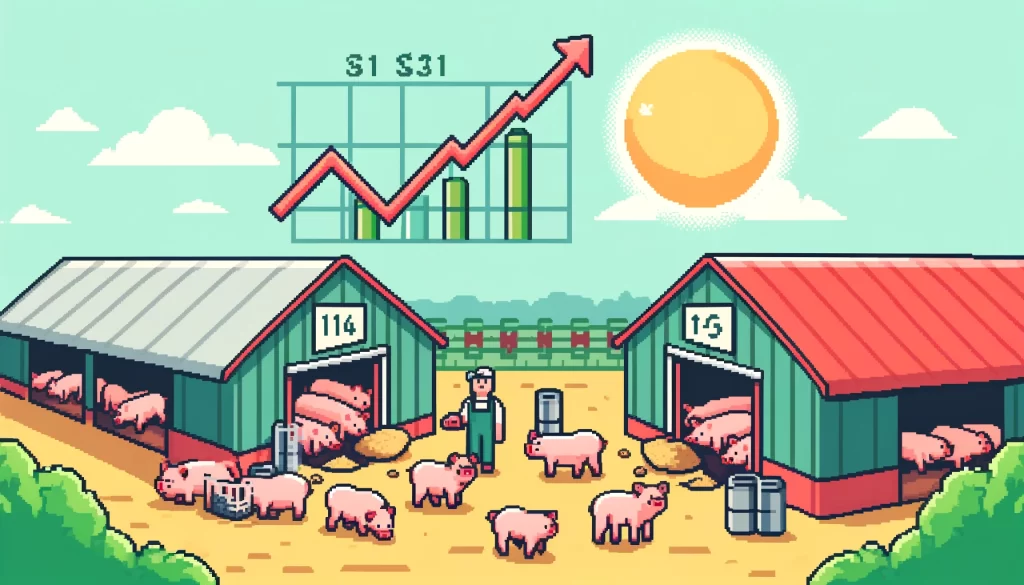
Reviving Mexico’s Pork Industry Amid Challenges
Ensuring a stable and efficient food supply is more critical than ever in a world where climate change poses escalating challenges. As global temperatures rise and weather patterns become increasingly unpredictable, maintaining secure agricultural production and distribution systems is crucial for feeding populations and stabilizing economies.
In Mexico, where a pork supply deficit and competitive market forces present additional obstacles, it’s vital to develop resilient farming practices and strategic logistics. Addressing these issues requires comprehensive planning and innovative management, ensuring that food producers can meet consumer demands while adapting to changing environmental conditions. The study of a Representative Pig Production Unit (RPPU150) in Mexico sheds light on the challenges and strategies that could help sustain this essential industry in the years to come.
The Farm and Production System:
The RPPU150 farm, located in the semi-tropical region of the State of Mexico, raises piglets from birth until they reach the market weight of 110 kg. The pigs are kept in specialized barns at different growth stages. After insemination and pregnancy confirmation, the sows spend around 116 days in gestation barns. A week before giving birth, they’re moved to maternity barns to nurse their piglets for 23 days.
Once weaned, piglets weighing 7.37 kg are transferred to nurseries for 26 days until they reach 19.28 kg. From there, they move through various barns and feeding stages until they are ready for sale.
The Model and Risk Assessment:
A stochastic model assessed the financial performance of the RPPU150 farm from 2022 to 2026, considering variables like income, costs, net cash, reserves, and return on assets. The model projected trends in key economic and financial indicators through 500 simulation iterations. It revealed a positive outlook for this representative farm despite the challenging market conditions.
Key Findings:
- Income and Expenses: Gross income is projected to grow by 27.93% over the five-year period, while expenses are expected to drop by 16.09%. This leads to an impressive 36% annual growth in net income.
- Risk Reduction: The probability of cash flow deficits decreases significantly, from 40% in 2022 to just 18% in 2026.
- Viability Indicators: The Net Present Value (NPV) in 2026 is expected to reach nearly 47,000 USD, while the Internal Rate of Return (IRR) is projected at 11.06%.
Production and Market Analysis: While the State of Mexico has experienced a decline in pork production since 1991, the overall national trend remains positive. The macroeconomic conditions affecting Mexico’s pork industry, like feed prices and exchange rates, directly impact production costs and competitiveness. However, efficient production practices, including improved feed strategies, can help smaller-scale farmers navigate these challenges and maintain profitability.
Strategies for Financial Stability:
- Feed Management: Since feed constitutes 88% of the farm’s total costs, it’s vital to develop local supply chains to stabilize prices.
- Market Efficiency: Streamlining distribution and developing short marketing circuits can enhance economic resilience.
- Policy Support: Protective tariffs or subsidies could help local producers remain competitive against international imports.
Conclusion:
This study demonstrates that under current conditions, medium-scale pig farms in Mexico can achieve sustainable economic and financial viability. Strategic planning, local supply chain development, and efficient production methods can help small- and medium-scale farms thrive despite market challenges.
Discussion Questions:
- How could local partnerships between pig farms and crop producers help stabilize feed costs and promote financial stability for both sectors?
- What policy measures might better support medium-scale pig farmers in Mexico while balancing the needs of consumers and importers?
Explore, Learn, and Grow with Science:
Step into the realm of discovery with ‘This Week in Science’! Tailored for both educators and science enthusiasts, our newsletter offers a weekly exploration of groundbreaking research and inspiring stories from the scientific community. By subscribing, you’re not just reading – you’re expanding your horizons in teaching and learning. Join us for free and start a journey that reshapes your engagement with science, fostering a more informed and passionate approach.
About the Author
Jon Scaccia, with a Ph.D. in clinical-community psychology and a research fellowship at the US Department of Health and Human Services with expertise in public health systems and quality programs. He specializes in implementing innovative, data-informed strategies to enhance community health and development. Jon helped develop the R=MC² readiness model, which aids organizations in effectively navigating change.



